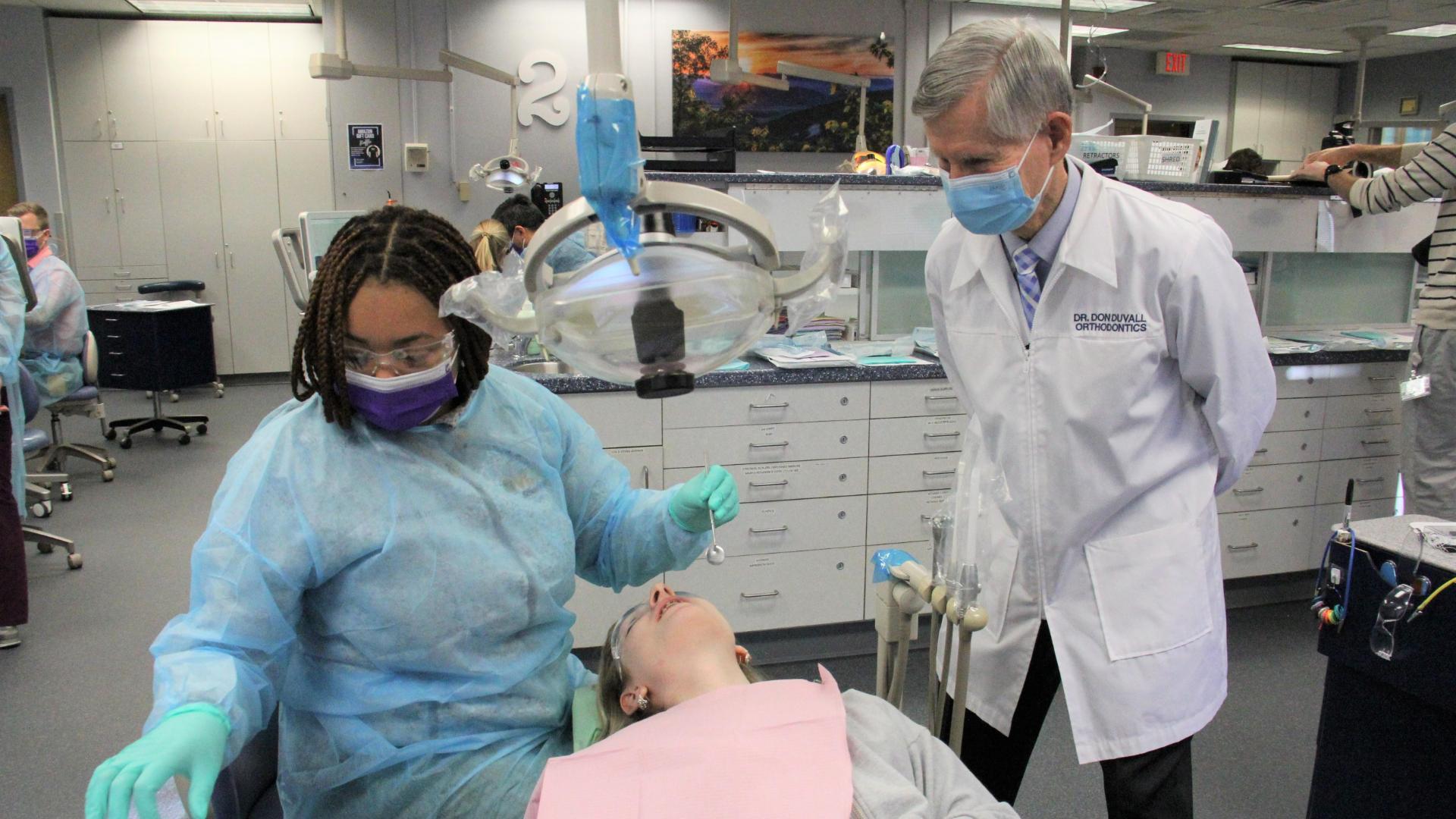Curriculum
The 24-month certificate program in orthodontics begins July 1 with two weeks of classes to familiarize students with concepts of growth and development, diagnosis and treatment planning, and basic biomechanical principles. First-year residents see new patients in the clinic in mid-July. In August, first-year residents begin a full clinic schedule that includes a morning and afternoon clinic session on most days.
Didactic course work at the department consists primarily of small group seminar sessions for an average of two hours each day.
Clinical work
Clinical work simulates a private-practice environment. Each team consists of one junior and one senior orthodontic resident and a dental assistant whose time is dedicated to that team. The orthodontic clinic has its own business manager, practice manager and receptionist. Patient records are computerized and billing, scheduling and record storage are accomplished using a commercial orthodontic office management system. The objective is to maximize clinical efficiency so residents fully develop the thought processes necessary to master orthodontic principles and treatment techniques. Graduates are prepared to enter into a successful and busy orthodontic practice.
Courses
A list and description of courses taken by the post-doctoral orthodontic residents appears below, or see the weekly schedule.
ORTH 532
Biomechanics: Theoretical Basis for Tooth Movement. Fall semester; 15 hours; one credit hour. Introduces physical science of mechanics and engineering statistics as applied to orthodontic force systems. Emphasizes equilibrium and the biologic manifestation of force systems applied to the dentition and craniofacial skeleton.
DENS 550
Update in Practice Administration. Fall semester; 14 seminar hours; one credit hour. Lectures and seminar discussion on the business aspects of contemporary specialty dental practice, with emphasis on entry into practice, associateship contracts, financing arrangements, risk management and employee relations.
DENS 630
Orthodontic-Periodontic-AEGD Conference. Both semesters; nine hours; 0.5 credit hours. Discusses treatment planning and analysis of patients requiring combined orthodontic, periodontic and general dental care. Presents topics of interest to orthodontists, periodontists and general dentists.
ORTH 650
Literature Review. Both semesters; 60 hours; four credit hours. Reviews classical articles in areas of special orthodontic interest. Establishes the state-of-the-art and existing information base. Gives special attention to research methodology and conclusions reached.
ORTH 652
Growth and Development. Fall semester; 30 hours; two credit hours. Discusses the increases in size and complexity that occur in the craniofacial region including variations in proportionality and related variations in facial form and dental occlusion. Provides special emphasis on compensations in skeletal and soft tissue structures. Examines the basis for prediction of change.
ORTH 654
Orthodontic Diagnosis and Treatment Planning. Both semesters; 60 hours; 4 credit hours. Considers and discusses available and theoretical options for clinical management of variations in facial form and dental occlusion.
ORTH 656
Current Literature. Both semesters; 45 hours; three credit hours. Presents in a journal club format the evaluation of current information in orthodontics and related disciplines. Includes special emphasis on research methodology and the contributions of current research to advances in orthodontics.
ORTH 658
Analysis of Orthodontic Treatment. Both semesters; 45 hours; three credit hours. Analyzes cephalometric and other objective measures of the outcomes of orthodontic therapy. Reviews treatment objectives with respect to actual changes effected in patients. Delineates changes resulting from therapy from changes resulting from normal variations in craniofacial development.
ORTH 660
Orthognathic Conference. Both semesters; 30 hours; two credit hours. Presents patients requiring coordinated orthodontic and oral surgery care. Emphasizes long-term and short-term biologic stability of alterations in the structure and function of the craniofacial skeleton with increased emphasis on facial form and dental occlusion.
ORTH 662
Craniofacial Anomalies. Both semesters; 30 hours; two credit hours. Discusses the etiology and embryologic basis of congenital and acquired deformities in the craniofacial structures. Emphasizes syndromes with craniofacial manifestations and the diagnosis and treatment planning for patients with facial clefts.
ORTH 680
Orthodontic Clinic. Both semesters; 1170 hours; 26 credit hours. Clinical management of orthodontic patients. Involves supervised experiences in treatment of a complete spectrum of normally occurring orthodontic problems in an environment simulating private practice.
DENS 699
Thesis Guidance. All semesters; 60 hours; 2 credit hours. Offers supervised experience in identifying potentially productive areas of orthodontic research. Requires that an original project be conducted under guidance and be submitted in a format suitable for publication.
